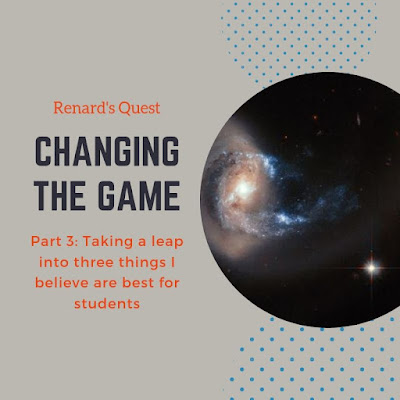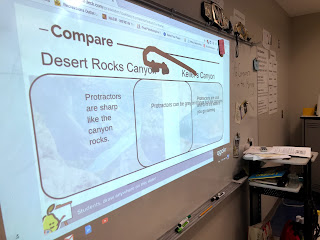When I get good ideas that I love and want to use in my classroom they go on a bucket list document I have on Google Keep. From there, I try to think of when it would be realistic to implement this idea and how it could be done. Will it work this school year or is it something that needs to be constructed over the summer? Ever since last summer, I have been inspired by PlayStation’s line of games called PlayLink. These are a series of games where players use a digital device (a phone or an iPad) to control what is happening. I have played two of these games and I really like both of them. So on my Crazy Ideas list sits two different crazy ideas. One is a cooperative assessment for teams of 2, where students make choices as they go that will affect what is happening later. The other is a review with branching paths where students play together with secret agendas of their own to complete as they go.
As the year was coming to a close, I decided to try a lesser version of both of these ideas in one activity. I created a math review akin to a Choose Your Own Adventure Book, like the ones we read as kids. I made it in Google slides with the intent of presenting it through PearDeck. I set a goal to have students work through 10 total problems whichever path they chose. With the branching path there are 14 total problem based slides in the presentation. It branches three times and students choices impact the problems they will complete, but they always come back together. We would complete the activity as a class with the students providing answers in PearDeck and receiving chips if they are correct.
To help organize which path is which, I placed a colored square or triangle in the bottom corner of each slide. Each slide also has a title in the upper left corner for linking purposes. I linked each slide in the presention to go where it was supposed to, but found that when I presented it in PearDeck, that those links would not work. Momentarily frustrating. Then I remembered that through the PearDeck dashboard feature I can jump from slide to slide as the story unfolds. This made the colored shapes even more handy, as students voted I could just progress by finding the next slide with that color.
Choice slides were represented by multiple choice questions. In PearDeck, this is represented with a Bar Graph I can share with students. Problem slides were a mix of draggable slides, short answer slides and drawing slides. I would keep track of the answers on the dashboard (which is on my phone) and reward chips as answers came in. This also allowed me to have students go back and check if needed.
As a gamer and movie fan, I really enjoy the Uncharted games and, of course, Indiana Jones. So the story is themed as a jungle adventure. I looked around online to find different problems that went with our content then modeled many of my problem slides after those. There was one toward the end that I screen grabbed from common core sheets, I was pressed for time and wanted students to find missing angles. I will likely fix this over the summer. After getting the problems together, I wrote tiny pieces of narrative to connect them. It is not Shakespeare, but it quite literally gets them from A to B.
Being the end of the year, I picked a Friday to try it out. I played the Uncharted soundtrack the entire time. Each student had a sheet of paper and signed into the PearDeck presentation, I ran the presentation on my laptop to see answers and used my Chromecast as a second screen to read the slides as I walked. I put a large number of Poker chips that I borrowed from Tom in a satchel. We started by going through the rules of the game. I explained that students could not go ahead, we would take slides as a team and make choices based on popularity. Each right answer would be worth two chips unless you were the first few answers in, then you would get three. This was purposefully ambiguous and designed to discourage cheating. Corrected answers would be worth one.
We began our adventure with a simple choice; right or left. With no real hint to go on, just make a choice. The students got their first problem and answered it. Thanks to the PearDeck dashboard, I was able to see their responses quickly and reward them for their work. If they were incorrect, I was able to redirect them just as fast. Then another choice and we were off. It took about three slides to click with every student and they ate it up. “Mr. Renard, I got it!”, could be heard all around the room, especially from my most competitive boys and girls. Some struggled a bit with harder questions. A couple had a wandering eye.
During the adventure, I also placed one or two other choices such as what equipment to grab or which boat to choose. Each of those decisions would affect later slides. This was the cause of much discussion and allowed my more social kids to work their magic. At one point when they reached a slide where they were attacked by a giant spider with three long division equations to solve, one boy shouted out, “See, I told y’all we should have taken the stupid torches, but No. You all wanted the rifles.” Suddenly, it was like we were in an action adventure film. It was my favorite moment of the day.
During the entire adventure most of the students had worked to keep up with eachother’s chips and where they were in comparison. In the end, we had 1 winner and two that tied for second place. The activity was a success and I have it locked in to review for next year.
The good: The students loved it! I was aiming to please all the different types of players that my students were and it definitely did that. There was excitement, talking, competition, choice, collaboration and most of all, 100% engagement. Every kid answered every question. It also changed the entire feel of the room. For one day, math class felt much more like a board game. This was the equivalent of a ten question spiral review quiz and you never would have known it if you had walked in.
The bad: It took a while to put it together. A few years ago, I got some good advice about putting new activities together. The teacher told me to look at prep time versus activity time. Admittedly, my endurance for that advice is greater than most, but it pushed my limits, as there was a lot more trial and error than I thought there might be. I spent a lot of time linking slides to find out that this doesn’t work in PearDeck. That said, I learned a lot about PearDeck’s capabilities and saw a few ways I could have saved time if and when I make another adventure like this one.
The other thing that I need to solve is how to completely curb cheating. Whenever there is competition, there will be one or two who resort to looking for help whether it is offered or not. I need to come up with a solution.
Modifications: There, as always, are a couple of errors that I need to fix. It was a lot of slides and errors happen. Additionally, I needed a clipboard with my role and 10 boxes each. Just to quickly keep track of who got chips and how many. I don’t think anyone took advantage of me dispensing rewards, but this would help me stay organized. Lastly, make sure you have enough currency for everyone and then some. Due to end of year scheduling, I took on a few (6) extra students at the last second and had to pull out base ten cubes for backup.
In the end, it was a great activity and I learned a ton doing it. I will do this adventure next year and likely build one or two more. I also have aspirations to do a room transformation for this activity, but I may recruit some help. Help is good.


















